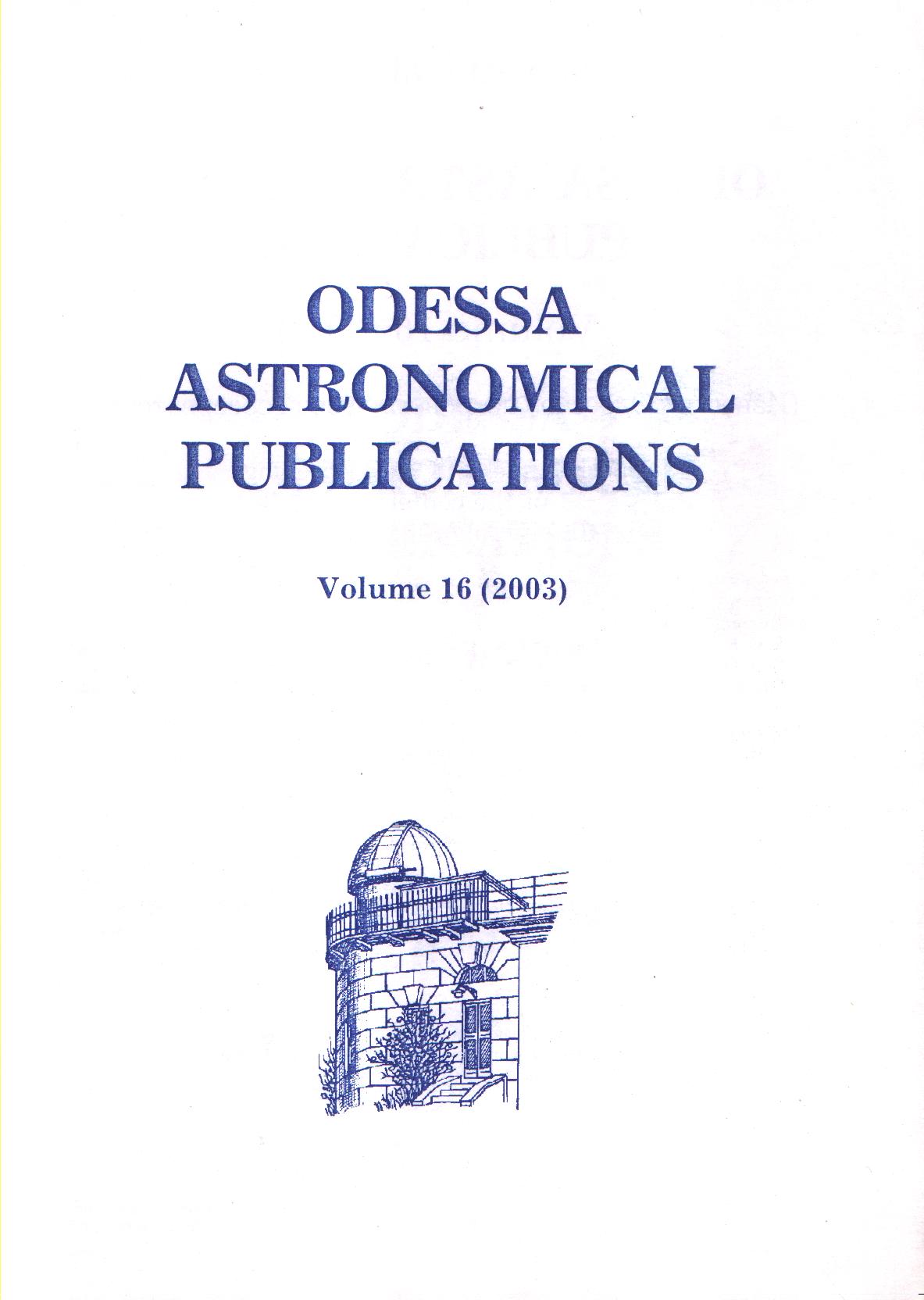Unstable processes in eclipsing polar HU Aquarii
DOI:
https://doi.org/10.18524/1810-4215.2003.16.97663Ключові слова:
accretion, stars, individual, HU Aqr (RXJ2107-05), binaries, cataclysmic variablesАнотація
We present the results of optical timeresolved spectroscopy and photometry of the eclipsing polar HU Aquarii, which were obtained with the help of the scanner of the 6 m telescope in July, 1994 and the CCD photometr of the 1 m telescope in September, 2002. Study of the parameters of Balmer and Hell emission lines in the spectra of HU Aqr has revealed significant variations with the phase of orbital period on a time-scale of 5-10 min and from day to day. Spectral light curves (integrated flux in the range of wavelengths 4000-500oA) have also shown significant variations. The bottom of the primary eclipses in the spectral light curves was 318 :I: 12 s with variable ingress (328-388 s) and egress (85-333 s). The form of the spectral light curves is strongly variable on a time scale of 1-15 hours. In particular the radial velocity curves on July 14, 1994 demonstrated a deviation from a sinusoid near the orbital phase 0.5 which is considered to be the result of occultation of the magnetic part of the accretion stream by the white dwarf. Simultaneously the spectral light curve has shown several features: the dip at the phase 0 is associated with the eclipse of the white dwarf and accretion stream by the secondary; at the phase % 0.85 the pre-eclipse dip due to the eclipse of the accretion spot by the accretion stream; the dip at the phase 0.5 which, as we suppose, is caused by the eclipse of the accretion spot by the white dwarf; at the phase 0.46 the pre-eclipse dip due to the eclipse of the accretion spot by the magnetic part of the stream. The two pre-eclipse dips at the phases 0.85 and 0.46 point to the location of the accretion spot on the magnetic field line between two parts of the accretion stream which come out from the spot along the field line in approximately opposite directions. The direction of the field line and the character of perturbation of the emission lines at the phase 0.5 exclude the location of the accretion spot in the accretion column and is an indication of the hot spot on a magnetic field line where the horizontal or ballistic part of the stream is captured by the magnetic field as it was predicted by Liebert and Stockman, 1985. The duration of the dip at the phase 0.5 gives the upper limit for the distance from the center of the white dwarf to the accretion spot of z 12Rwd. The location of the accretion spot is far from the basis of the accretion column and should be considered as a second hot spot in the system. The hot spot is the principal source of the optical radiation of the system in the high state of accretion. The absence of the dips at the phases 0.5, 0.46 and 0.85 on other neighboring dates of our observations is the evidence of the instability of accretion geometry on the time-scale of 1 day. Photometrical observations during two nights in September 2002 found HU Aqr in the intermediate state, closer to the low state of brightness of the system. The light curve in V filter showed only the primary eclipse without the dips at the phases of 0.5 and 0.85.Посилання
Afanasiev V.L., Lipovetsky V.A., Mikhajlov V.P., Nazarov E.A., Shapovalova A.I.: 1991, Astrofiz.Issled.(Izv. SAO), 31, 128.
Cropper M.: 1990, Space Sci. Rev, 54, 195.
Drabek S.V., KOpylovI.1/I., Somov N.N., Somova. T.A.: 1986, Astrofiz.Issled.(Izv. SAO), 22, 64.
Hakala. P.J., Watson M.G., Vilhu O., Hassall B.J.M., Kellett B.J., Mason K.O., Piirola V.:1993, MNRAS, 263, 61.
Liebert J., Stockman H.S.: 1985,in: CVs and LMXBs, eds. D. Q. Lamb and J. Patterson, 151.
Schwope A.D., Tomas H.C., Beuermann K.: 1993, Astronomy and Astrophysics, 271, L25.
Schwope, A.D., Schwarz, R., Sirk, M., Howell, SB: 2001, Astronomy and Astrophysics, 375, 419.
Somova T.A., Somov N.N., Markelov S.V., Nebelitsky V.B., Spiridonova O.I., Fomenko A.F.: 1982, in: Instrumentation for Astronomy with Large Optical Telescopes, ed. C.M.Humphries,
Reidel, 283.
Warner B.: 1995, Cataclysmic Variable Stars (Cambridge: Cambridge Univ. Press).
##submission.downloads##
Опубліковано
Як цитувати
Номер
Розділ
Ліцензія
Авторське право (c) 2017 Odessa Astronomical Publications

Ця робота ліцензується відповідно до Creative Commons Attribution-NonCommercial 4.0 International License.
Відповідно Закону України про авторське право і суміжні права N 3792-XII від 23 грудня 1993 року
